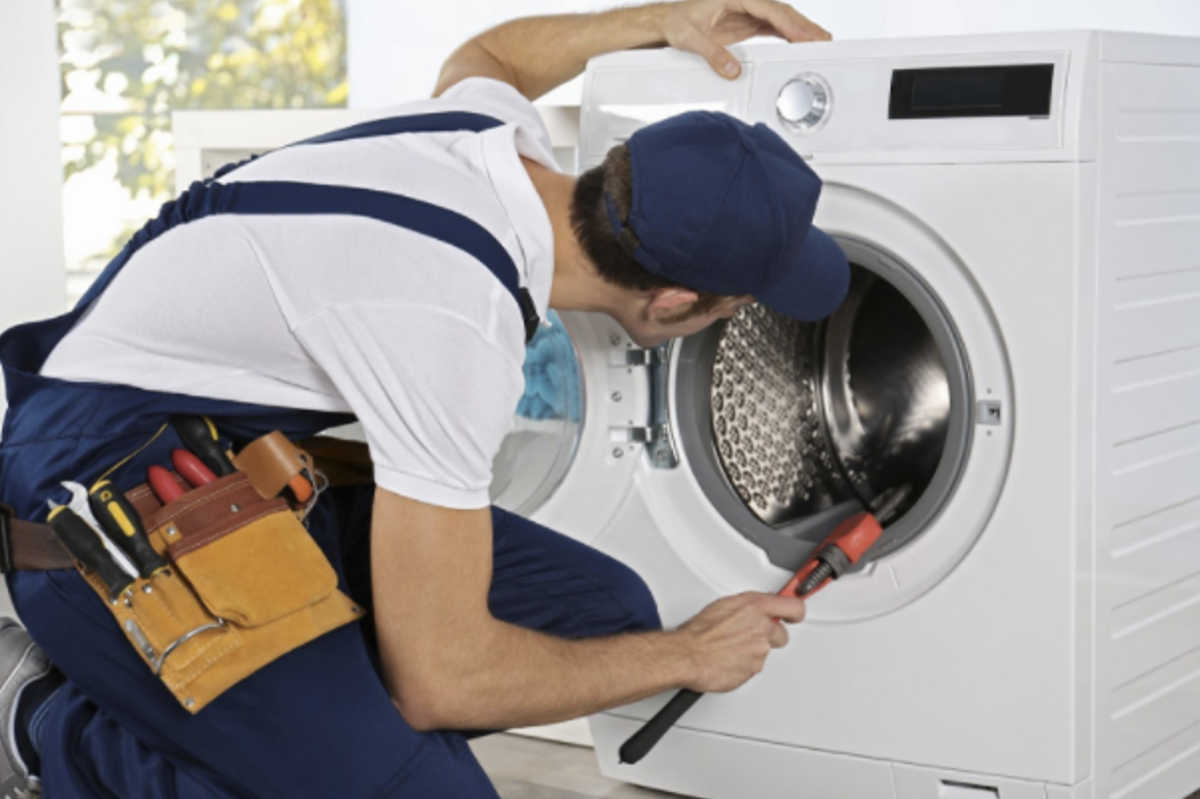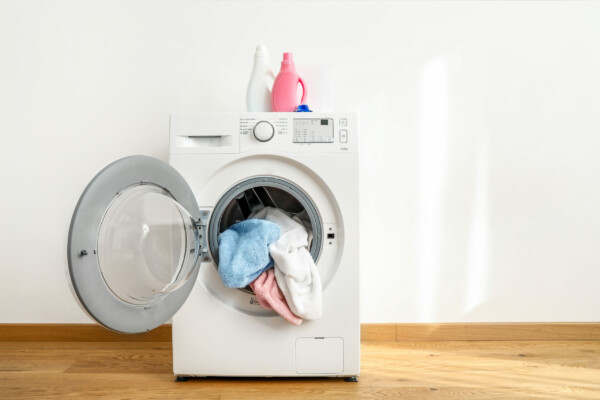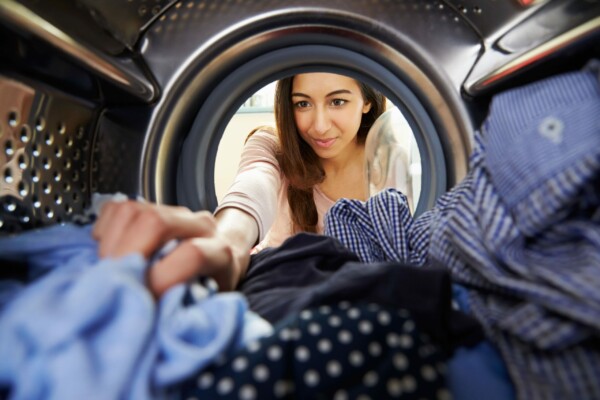Why Is the Washing Machine Leaking From the Bottom?
Before thinking about replacing your home washer or repairing the appliance, make sure you know exactly what causes a washer to leak from the bottom. Based on years of experience, we know that a washing machine leaking from the bottom is a symptom of multiple issues — here’s a review of the most common ones.
Issue #1. Faulty Gaskets
Gaskets play a crucial role in ensuring that no water seeps into the gap between the appliance’s cover and its external structure. When gaskets develop worn spots, it leads to leaks. Fortunately, resolving this issue is usually straightforward – simply remove the front cover of the washer and tighten the bolts to improve the gasket’s positioning.
If the damage to the gasket is severe, it’s best to opt for replacing the faulty washer component as the most practical solution.
Issue #2. Leaky Hoses
In most washers, each hose serves to connect the machine to an external water source. If these hoses are damaged or if the fittings are ill-fitting, the appliance may start leaking water. Internal hoses could also be at fault; they may have developed leaks or have faulty connections, causing them to leak during water cycles.
To access the internal hoses, remove the upper section of the appliance cabinet, inspect the hoses for abrasions or cracks, and ensure the connections are secure. Corrosion and perforations are warning signs of a washing machine leaking from the bottom that should be monitored closely.
Issue #3. Pulley Seal Leaks
If the washing machine is leaking from the bottom, the culprit could be the pump. It’s important to note that depending on the type of pump employed, warning signs may differ. Most washing machines utilise one of the following three pump types:
- Direct-drive
- Belted
- An electric system for pumping.
However, the most common problems to watch for are loose clamps around hoses or a leaking hose.
To reach the pump, take off either the back or front cover of your appliance (different models have different methods for accessing the pulley seal). After that, disconnect the hoses, detach the belt, or unfasten the pump. Once you can directly reach the pump, examine it for any indications of damage or deterioration.
Issue #4. Door Seal Issues
The reasons for a washing machine leaking from the bottom during the spin cycle vary from highly damaging to absolutely non-invasive. Door seal malfunctions fall in the latter category and are easy to fix. For one thing, in most cases, the water starts leaking from the bottom of the washing machine because something prevents the front-loading door from shutting entirely — dirt, excessive detergent, etc.
Even if the equipment itself is faulty, replacement is easy and cheap — be sure to ask the manufacturer for assistance and choose the correct seal model.
Issue #5. Pressure Switch Miscommunication
As its name implies, the pressure switch oversees the water level within the washer and may be the cause of a washing machine leaking from the bottom during the filling process. If it malfunctions and doesn’t respond to water overflow, leaks are bound to occur. Remove the control panel from the washing machine to examine the pressure switch. Check it for signs of wear or cracks, and make sure the connection between the washing machine’s wire and the water source is firmly secured.
If a switch shows a pressure decrease, the component is likely faulty and needs to be replaced.
How to Fix Washing Machine Leaks?
Depending on the system component that is leading to a front load washing machine leaking from the bottom, there are different ways to troubleshoot the issue — here are the most common ones:
Tip #1. Run a Hose Inspection
There are two types of hoses a washing machine owner needs to check if concerned for a washer leaking water from the bottom — the drain and fill hoses. Here’s how you can inspect both in under a few minutes:
- Step #1. Unplug the washer and ensure the connections at the back of the appliance are tight.
- Step #2. If a superficial inspection shows no signs of a leak, you might need to run an in-depth assessment. Detach the cabinet component of the appliance to get direct access to its hoses.
- Step #3. Check for any cracks or abrasions in the structure of a hose.
- Step #4. Replace a hose if you see signs of damage — you don’t have to change all of them at once and can remove only the worn-out one.
Tip #2. Inspect the Tub Gasket
Here’s how you can ensure that the gasket connecting both tubs of the home washer is tightly sealed.
- Step #1. Unplug the appliance and disconnect the device’s front cabinet.
- Step #2. Take off the tub’s cover to gain direct entry to the gasket.
- Step #3. Analyze the gasket for potential damage, scratches, signs of aging and wear.
- Step #4. If you detect cracks, start looking for a replacement gasket and install it in the washer.
Tip #3. Assess the inlet valve
To make sure an inlet valve malfunction does not obstruct the water flow, run a short inspection:
- Step #1. Ensure the washing machine is unplugged and has no access to the water source.
- Step #2. Detach the rear panel of the appliance to view the inlet valve. In most washers, the inlet valve can be found behind the hose connections.
- Step #3. Examine the valve screens for any accumulation of debris and dirt. When dirt and grime accumulate, they can disrupt the valve’s function, hindering efficient control of water entry. Consequently, water from the external source may cause leaks from the bottom of the washer.
- Step #4. Conduct a test using a multimeter probe. Set the multimeter to the Rx1 mode, attach the probe to the valve exit, and take a reading. Then, compare the result with the user manual of your washer to ensure there are no irregularities.
- Step #5. If the probe reads the infinity error code or you see signs of damage, replace the inlet valve.
Fix Appliances CA — Professional Team For Repairing Washing Machine Leaks
If you are not a professional technician, you may lack the skills or equipment to fix a broken washing machine on your own. That’s why hiring professionals for repair help is a safer bet for the longevity of your appliances and a reasonable investment.
When looking for a team of repair technicians in Canada, consider FIX Appliances CA — your go-to choice. Our technicians help homeowners and businesses nationwide fix and repair common electric appliance issues.
Here’s why FIX Appliances CA is the team you can trust in:
- 18+ years of experience in washing machine leaks, motor issues, and other types of repair and maintenance.
- Supporting homeowners with high-quality washing machine parts from leading manufacturers.
- Trained support staff to answer your questions and provide around-the-clock assistance.
- Affordable repair cost for house and commercial property owners.
- Wide range of services — you can trust FIX Appliances CA technicians to repair anything from refrigerators and ovens to washing machines and clothes dryers. You can trust our technicians to handle most appliance maintenance tasks without having to reach out to different teams.
We look forward to helping you achieve the peak efficiency of every electric appliance you use. If you have an appliance performance issue or need help installing an appliance — leave us a message or call us at 888-242-0777
Date of page creation: April 29, 2020
Page update date: April 08, 2024
What Our Customers Say About Us
FAQ: Top Frequently Asked Questions
Why is my washing machine leaking from the bottom?
How can I identify and fix faulty gaskets in my washing machine?
1. Take off the front cover and tighten any loose bolts to improve the gasket's seal.
2. If the damage is extensive, consider replacing the faulty gasket for a more effective solution.
What should I do if the hoses in my washing machine are leaking?
1. Check hose connections for tightness and signs of damage.
2. Inspect the internal hoses for abrasions or cracks. Replace any damaged hoses and ensure a secure fit to prevent leaks.
What steps can I take to address pump-related leaks in my washing machine?
1. Access the pump by removing the appliance's front or rear cover.
2. Examine the pump for signs of wear and tear, loose clamps, or a leaking hose.
3. Depending on the issue, tighten clamps, replace hoses, or replace the pump itself if necessary.
How do I troubleshoot a malfunctioning pressure switch causing leaks in my washing machine?
1. Disconnect the control panel to access the pressure switch.
2. Inspect the pressure switch for wear or cracks and ensure the connection to the water source is secure.
3. If the switch shows signs of malfunction or pressure decrease, it may need to be replaced.





